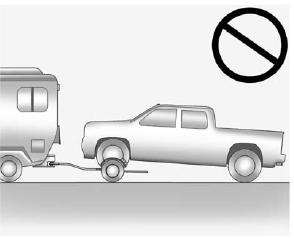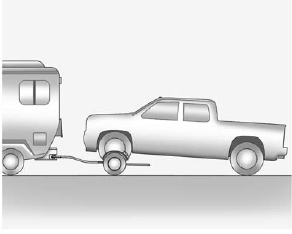Dolly Towing

Front Towing (Front Wheels Off the Ground) – Two-Wheel-Drive Vehicles
Notice: If a two-wheel drive vehicle is towed with the rear wheels on the ground, the transmission could be damaged.
The repairs would not be covered by the vehicle warranty. Never tow the vehicle with the rear wheels on the ground.
Two-wheel-drive vehicles should not be towed with the rear wheels on the ground. Two-wheel-drive transmissions have no provisions for internal lubrication while being towed.
To dolly tow a two-wheel-drive vehicle, the vehicle must be towed with the rear wheels on the dolly.
See “Rear Towing (Rear Wheels Off the Ground)” later in this section for more information.

Front Towing (Front Wheels Off the Ground) – Four-Wheel-Drive Vehicles
Use the following procedure to dolly tow a four-wheel-drive vehicle from the front:
1. Attach the dolly to the tow vehicle following the dolly manufacturer's instructions.
2. Drive the front wheels onto the dolly.
3. Shift the transmission to P (Park).
4. Firmly set the parking brake.
WARNING
Shifting a four-wheel-drive vehicle's transfer case into N (Neutral) can cause the vehicle to roll even if the transmission is in P (Park). The driver or others could be injured. Make sure the parking brake is firmly set before the transfer case is shifted to N (Neutral).
5. Use an adequate clamping device designed for towing to ensure that the front wheels are locked into the straight position.
6. Secure the vehicle to the dolly following the manufacturer's instructions.
7. Shift the transfer case to N (Neutral). See “Shifting into Neutral” under Four-Wheel Drive on page 9‑43 for the proper procedure to select the neutral position for the vehicle.
8. Release the parking brake only after the vehicle being towed is firmly attached to the towing vehicle.
9. Turn the ignition to LOCK/OFF.
After towing, see “Shifting Out of Neutral” under Four-Wheel Drive on page 9‑43.
See also:
TPMS Malfunction Light and Message
The TPMS will not function properly if one or more of the TPMS sensors are missing or inoperable. When the system detects a malfunction, the low tire warning light flashes for about one minute and the ...
Tire Designations
Tire Size
The following is an example of a typical passenger vehicle tire size.
(A) Passenger (P-Metric) Tire:
The United States version of a metric tire sizing system.
The letter P as the first ...
Reporting Safety Defects to the United States Government
If you believe that your vehicle has a defect which could cause a crash or could cause injury or death, you should immediately inform the National Highway Traffic Safety Administration (NHTSA) in addi ...





